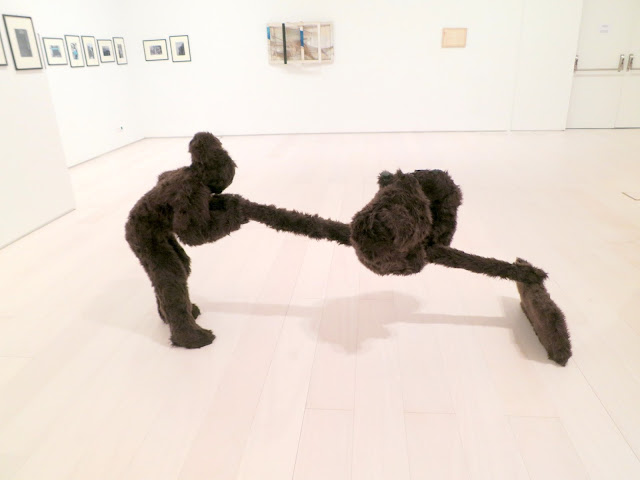Documenta 14 at the National Museum of Contemporary Art, Athens - part 3
My last post on the Documenta 14 exhibition at the National Museum of Contemporary Art.
Coming down the stairs from the top galleries we saw this monumental sculpture:
Cecilia Vicuna, Quipu Womb, (The Story of the Red Thread, Athens), 2017
In this sculpture Vicuna suspends thick masses of knotted red wool from a circular metal frame. Reminiscent of umbilical cords, blood or even matted hair, quipu was originally an Incan system for recording events with knotted strings. Here, the poet Vicuna symbolically suggests the joining of word, narrative history and flesh as we imagine the bloodshed of past regimes, including Chile's Pinochet, which resonates with today's landscape of war and brutality.
Via the umbilical cord of menstrual symbolism, this work furthermore connects Andean mother goddesses with the maritime mythologies of ancient Greece.
McDermott and McGough, The Greek Way, 2001
'The Greek Way' was a euphemism in the 20th century for homosexuality, at a time when western societies had repressive attitudes towards openly gay men and women.
This is an installation where ancient Greek homosexuality, the Hellenistic principles and the Golden Age of Greece, plus the Third Reich's Aryan propaganda are all interconnected. The paintings of McDermott and McGough from their series Hitler and the Homosexuals, present images of Hitler over-painted with the names of gay murder victims, plus their dates of birth/arrest/murder.
On another wall of the installation, Piotr Uklanski's paintings based on film stills from Leni Riefenstahl's Olympia (1936-38) are presented.
Openly gay men and women were among Hitler's first targets for persecution in the name of purifying German society, condemning them as 'socially aberrant'. Functioning as memento mori, each of McDermott and McGough's Hitler paintings deface an idealised propaganda image of the Fuehrer by over-painting the name of a gay murder victim along with the dates of their birth, arrest and murder. Uklanski's Greek Way paintings tease out the simmering homoerotic undercurrents of Riefenstahl's film that conflates Hellenistic imagery with her propagandistic 'celebration of beauty' in order to create a subversive counter narrative of the Third Reich's homophobia and genocide.
George Lappas, Gardener with Little Bear, 2013
Maria Lai, Threads of Spatial Sail, 2007 (thread, fabric, wood)
looking closer
Maria Lai, Thread of Geometry, 2009, (wood, fabric, thread)

Maria Lai, Geography, 1994, (fabric and thread)
Maria Lai, To Gramsci, 2008, (fabric, thread, felt-tip pen)
Maria Lai, Window on the Loom, 1972, (painted wood and string)
Thomas Love, Working, 2016
Spiro Kristo, The brigadier, 1976
A number of paintings glorifying the past socialist 'work ethic' from Tirana's National Gallery of Arts. It's the first time I've seen art from Albania
Zef Shoshi, The Turner, 1969
Hasan Nallbani, The Action Worker, 1966
Andrzej Wroblewski, Mother with a Killed Child, 1949
Andrezej Wroblewski, Execution Against a Wall, 1949.



























Such a powerful exhibition. Thank you for giving us a good glimpse - and particularly thanks for introducing me to the work of Maria Lai.
ReplyDeletePhotographs don't do Maria Lai's work justice, Olga: it's innovative, powerful, imaginative and intriguing. I was stunned by it, and then, when I looked at the photographs I thought how diminished it looked. I was very pleased to have the opportunity to see it 'in the flesh' so to speak, but, some of the power must come across in the photographs since you have singled it out. I am glad.
Delete